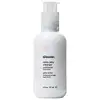What's inside
What's inside
 Key Ingredients
Key Ingredients

 Benefits
Benefits

 Concerns
Concerns

 Ingredients Side-by-side
Ingredients Side-by-side

Water
Skin ConditioningGlycerin
HumectantLauryl Hydroxysultaine
CleansingPotassium Cocoyl Glycinate
Coco-Glucoside
CleansingAcrylates Copolymer
1,2-Hexanediol
Skin ConditioningSodium Methyl Cocoyl Taurate
CleansingEthylhexylglycerin
Skin ConditioningTromethamine
BufferingDisodium EDTA
Dextrin
AbsorbentButylene Glycol
HumectantTheobroma Cacao Seed Extract
AntioxidantMelia Azadirachta Leaf Extract
Skin ConditioningMelia Azadirachta Flower Extract
Skin ConditioningCarthamus Tinctorius Flower Extract
Skin ConditioningMethylpropanediol
SolventCoccinia Indica Fruit Extract
Skin ConditioningAloe Barbadensis Flower Extract
EmollientSolanum Melongena Fruit Extract
Skin ConditioningNymphaea Alba Flower Extract
Skin ConditioningNymphaea Caerulea Flower Extract
Skin ConditioningSimmondsia Chinensis Seed Oil
EmollientRoyal Jelly
Honey
HumectantCorallina Officinalis Extract
Skin ConditioningCurcuma Longa Root Extract
MaskingOcimum Sanctum Leaf Extract
Skin ConditioningMineral Salts
Skin ConditioningHouttuynia Cordata Extract
Skin ConditioningCarthamus Tinctorius Seed Extract
Skin ConditioningLycium Chinense Fruit Extract
AntioxidantPanax Ginseng Root Extract
EmollientArtemisia Capillaris Leaf Extract
Skin ConditioningAloe Barbadensis Leaf Juice Powder
Skin ConditioningCitric Acid
BufferingSodium Benzoate
MaskingParfum
MaskingLimonene
PerfumingLinalool
PerfumingWater, Glycerin, Lauryl Hydroxysultaine, Potassium Cocoyl Glycinate, Coco-Glucoside, Acrylates Copolymer, 1,2-Hexanediol, Sodium Methyl Cocoyl Taurate, Ethylhexylglycerin, Tromethamine, Disodium EDTA, Dextrin, Butylene Glycol, Theobroma Cacao Seed Extract, Melia Azadirachta Leaf Extract, Melia Azadirachta Flower Extract, Carthamus Tinctorius Flower Extract, Methylpropanediol, Coccinia Indica Fruit Extract, Aloe Barbadensis Flower Extract, Solanum Melongena Fruit Extract, Nymphaea Alba Flower Extract, Nymphaea Caerulea Flower Extract, Simmondsia Chinensis Seed Oil, Royal Jelly, Honey, Corallina Officinalis Extract, Curcuma Longa Root Extract, Ocimum Sanctum Leaf Extract, Mineral Salts, Houttuynia Cordata Extract, Carthamus Tinctorius Seed Extract, Lycium Chinense Fruit Extract, Panax Ginseng Root Extract, Artemisia Capillaris Leaf Extract, Aloe Barbadensis Leaf Juice Powder, Citric Acid, Sodium Benzoate, Parfum, Limonene, Linalool
Water
Skin ConditioningRosa Damascena Flower Water
MaskingGlycerin
HumectantPropanediol
SolventIsohexadecane
EmollientAcrylamide/Sodium Acryloyldimethyltaurate Copolymer
Emulsion StabilisingSodium Hyaluronate
HumectantPanthenol
Skin ConditioningAllantoin
Skin ConditioningSymphytum Officinale Root Extract
Skin ConditioningXylitylglucoside
HumectantBetaine
HumectantAnhydroxylitol
HumectantXylitol
HumectantAmmonium Polyacryloyldimethyl Taurate
Emulsion StabilisingEthylhexylglycerin
Skin ConditioningPolysorbate 80
EmulsifyingSorbitan Oleate
EmulsifyingBenzoic Acid
MaskingCitric Acid
BufferingSodium Hydroxide
BufferingPotassium Sorbate
PreservativeSodium Benzoate
MaskingGeraniol
PerfumingCitronellol
PerfumingWater, Rosa Damascena Flower Water, Glycerin, Propanediol, Isohexadecane, Acrylamide/Sodium Acryloyldimethyltaurate Copolymer, Sodium Hyaluronate, Panthenol, Allantoin, Symphytum Officinale Root Extract, Xylitylglucoside, Betaine, Anhydroxylitol, Xylitol, Ammonium Polyacryloyldimethyl Taurate, Ethylhexylglycerin, Polysorbate 80, Sorbitan Oleate, Benzoic Acid, Citric Acid, Sodium Hydroxide, Potassium Sorbate, Sodium Benzoate, Geraniol, Citronellol
 Reviews
Reviews

Ingredients Explained
These ingredients are found in both products.
Ingredients higher up in an ingredient list are typically present in a larger amount.
Citric Acid is an alpha hydroxy acid (AHA) naturally found in citrus fruits like oranges, lemons, and limes.
Like other AHAs, citric acid can exfoliate skin by breaking down the bonds that hold dead skin cells together. This helps reveal smoother and brighter skin underneath.
However, this exfoliating effect only happens at high concentrations (20%) which can be hard to find in cosmetic products.
Due to this, citric acid is usually included in small amounts as a pH adjuster. This helps keep products slightly more acidic and compatible with skin's natural pH.
In skincare formulas, citric acid can:
While it can provide some skin benefits, research shows lactic acid and glycolic acid are generally more effective and less irritating exfoliants.
Most citric acid used in skincare today is made by fermenting sugars (usually from molasses). This synthetic version is identical to the natural citrus form but easier to stabilize and use in formulations.
Read more about some other popular AHA's here:
Learn more about Citric AcidEthylhexylglycerin (we can't pronounce this either) is commonly used as a preservative and skin softener. It is derived from glyceryl.
You might see Ethylhexylglycerin often paired with other preservatives such as phenoxyethanol. Ethylhexylglycerin has been found to increase the effectiveness of these other preservatives.
Glycerin is already naturally found in your skin. It helps moisturize and protect your skin.
A study from 2016 found glycerin to be more effective as a humectant than AHAs and hyaluronic acid.
As a humectant, it helps the skin stay hydrated by pulling moisture to your skin. The low molecular weight of glycerin allows it to pull moisture into the deeper layers of your skin.
Hydrated skin improves your skin barrier; Your skin barrier helps protect against irritants and bacteria.
Glycerin has also been found to have antimicrobial and antiviral properties. Due to these properties, glycerin is often used in wound and burn treatments.
In cosmetics, glycerin is usually derived from plants such as soybean or palm. However, it can also be sourced from animals, such as tallow or animal fat.
This ingredient is organic, colorless, odorless, and non-toxic.
Glycerin is the name for this ingredient in American English. British English uses Glycerol/Glycerine.
Learn more about GlycerinSodium Benzoate is a preservative. It's used in both cosmetic and food products to inhibit the growth of mold and bacteria. It is typically produced synthetically.
Both the US FDA and EU Health Committee have approved the use of sodium benzoate. In the US, levels of 0.1% (of the total product) are allowed.
Sodium benzoate works as a preservative by inhibiting the growth of bacteria inside of cells. It prevents the cell from fermenting a type of sugar using an enzyme called phosphofructokinase.
It is the salt of benzoic acid. Foods containing sodium benzoate include soda, salad dressings, condiments, fruit juices, wines, and snack foods.
Studies for using ascorbic acid and sodium benzoate in cosmetics are lacking, especially in skincare routines with multiple steps.
We always recommend speaking with a professional, such as a dermatologist, if you have any concerns.
Learn more about Sodium BenzoateWater. It's the most common cosmetic ingredient of all. You'll usually see it at the top of ingredient lists, meaning that it makes up the largest part of the product.
So why is it so popular? Water most often acts as a solvent - this means that it helps dissolve other ingredients into the formulation.
You'll also recognize water as that liquid we all need to stay alive. If you see this, drink a glass of water. Stay hydrated!
Learn more about Water